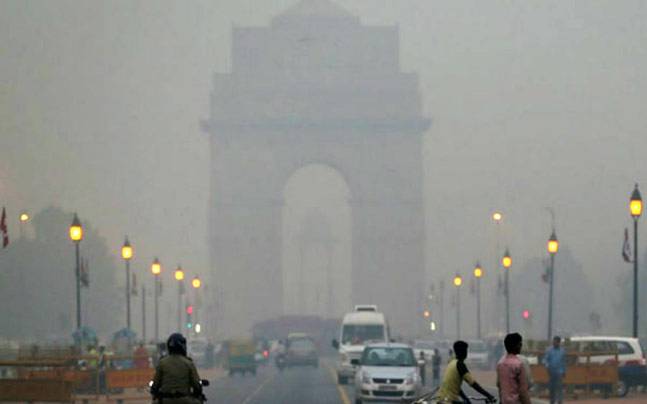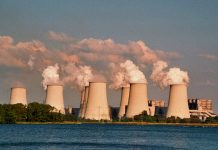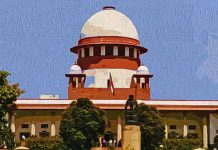This article has been written by Oishika Banerji of Amity Law School, Kolkata. This article encircles the Delhi air pollution that has recently taken a mammoth shape and is affecting the life and livelihoods of all living creatures in and around the capital of India, Delhi.
Table of Contents
Introduction
As the country is slowly recovering from the pandemic threats existing for more than a year now, air pollution has been replacing the pandemic to ensure that dangers possessed to the lives of living beings are not over as of now. With the Air Quality Index (AQI) ranging from 297 AQI to 334 AQI, that is from poor to very poor, Delhi and its surrounding regions are waking up every day in the midst of thick smog cover. The repeated conflict between the Centre and the judiciary and many still continuing, have revealed that although the intentions of the government are highly praisable, the executive terribly lacks in implementation of the policies framed by it along with the existing environmental legislation. The Supreme Court of India alongside the Delhi High Court have by means of several decisions, been trying continuously to keep in check the rising air pollution in and around the capital city of India, Delhi. While the courts have listed down several possible reasons behind an uncontrollable rise in air pollution, the Centre has also provided their views concerning the sources of air quality degradation. The case of Aditya Dubey v. Union of India (2021) which has been discussed exhaustively in this article, is a living example of interchanging views between the executive and judicial wings of the government. This article tries to incorporate all the associated events and repercussions surrounding the Delhi air pollution thereby laying down possible solutions to address the issue of the absence of implementation of rules and regulations in environmental matters.
The worsening condition of Delhi’s air quality : an insight
- Delhi has been the second most polluted city on the planet with an AQI of 349, said iQair, a website that tracks air pollution worldwide. The only other Indian city on the website’s list of 10 was Kolkata being the fifth most polluted city worldwide with an AQI of 186.
- Due to agricultural stubble burning, emissions from transportation, coal-fired plants outside the city, and other industries, as well as open waste burning and dust, air quality in Delhi, which is frequently regarded as the world’s most polluted capital, has deteriorated in recent times.
- The Chief Justice of India, NV Ramanan has requested the government to devise an emergency strategy to combat the deadly pollution, describing the situation as ‘extremely severe’. The Centre Pollution Control Board has instructed states and local governments to be completely prepared for emergency measures to combat rising smog conditions in New Delhi owing to a dip in temperature and wind speeds. According to the Central Pollution Control Board, visibility was impaired, and the Air Quality Index (AQI) reached 470 on a scale of 500.
- In Delhi, authorities had closed all schools and universities indefinitely due to rising levels of air pollution for a period of fifteen days. Construction activity had also been prohibited until November 21, with the exception of transportation and defense-related projects. The Delhi administration had also announced that it was considering a lockdown to improve air quality.
The Commission for Air Quality Management in National Capital Region and Adjoining Areas Act, 2021
With an aim to create an overarching body to consolidate all monitoring bodies, and to bring them on one platform so that air quality management can be carried out in a more comprehensive, efficient, and time-bound manner, the Commission for Air Quality Management in National Capital Region and Adjoining Areas Act, 2021 was promulgated on 13th April, 2021. Every winter, when air pollution levels in the National Capital Region begin to rise, both the federal and state governments bear the brunt of the blame. While the commission will focus on improving air quality during the winter months, it has also been urged to propose pollution-reduction measures throughout the year.
Demonstrations against a portion of the Bill that provided a penalty for stubble burning began during the farmers’ protests when labour organisations spoke out against it. The Centre has given in to their demands by decriminalizing stubble burning and other forms of pollution, for farmers. These infractions formerly carried a penalty of up to 5 years in prison and a fine of Rs 1 crore, the Union Ministry of Environment and Forests and Climate Change (MoEF)’s harshest penalty for air pollution offences to date. While the penalty is still in place for other industries and individuals, the agricultural community is no longer subject to it.
The Commission has replaced the Supreme Court-appointed Environment Pollution (Prevention and Control) Authority (EPCA), which had been in operation for 22 years, and consolidated all entities that monitored, investigated, and planned abatement of air pollution in the region. The EPCA’s authority had dwindled over time and had become superfluous and ineffectual in tackling concerns relating to air pollution, according to the Centre. In addition, the EPCA also lacked the penalties that the Commission will now have.
The Apex Court’s direction to the Commission in controlling air pollution
The directions provided by the Apex Court to the Commission for Air Quality Management in National Capital Region and Adjoining Areas, in light of the Delhi-NCR air pollution are provided hereunder:
- The Commission must commission a scientific investigation of air quality based on last year’s available data and documented levels of air pollution. Seasonal fluctuations and other important aspects must be taken into account in the research.
- Once a scientific model that takes into account wind velocity, as well as natural and man-made events, is available, the graded response plan may be tweaked to allow for steps to be implemented in advance, rather than waiting for air quality to degrade.
- Steps can be planned at least a week ahead of time, if not even earlier, based on expected levels of air pollution in the near future.
- Within a month, the Commission must complete the aforementioned exercise and report on the efforts taken to comply with this directive.
Role of the Supreme Court of India in curbing the ongoing fiasco
A three-Judge Bench of the Supreme Court of India consisting of Chief Justice NV Ramanan, Justices D.Y. Chandrachud and Surya Kant, while hearing a civil Writ Petition filed by a 17-year-old student Aditya Dubey, analyzed the ongoing Delhi air pollution by placing it under different heads which have been discussed hereunder.
Stubble burning by farmers
Farmers have been subjected to blame for over several years now for majorly contributing to the rising air pollution in and around Delhi because of their farming practices which are not environment-friendly. Once again while hearing the case of Aditya Dubey v. Union of India (2021), the issue of farmers contributing to air quality degradation came up before the Supreme Court of India. On 15th November 2021, the Centre informed the Apex Court that farmers’ stubble burning generates barely 4-10 percent of Delhi’s pollution. Although the contribution of the farmers was barely noticeable in this fiasco, the Supreme Court had ordered the Centre to convene an emergency meeting of Punjab, Haryana, Delhi, and Uttar Pradesh on 16th November 2021 to take immediate steps to persuade farmers to stop burning stubble. The Court further added that if needed a lockdown would be declared if the air quality turns for the worse.
Construction work of Central Vista project
There were several allegations surrounding the Central Vista project terming the same as the major source causing air pollution in and around the Delhi-NCR region. Despite the Supreme Court’s restriction on building activities in Delhi-NCR areas to combat air pollution, Senior Advocate Vikas Singh, representing the petitioner, Aditya Dubey, told a bench chaired by Chief Justice of India NV Ramana that the Central Vista works were continuing in full swing. Addressing Mr Singh, the CJI said “Now we’re struggling to control pollution whether it is Central Vista or pollution industries, etc. Don’t think we don’t know anything”. The bench, which also included Justices DY Chandrachud and Surya Kant, directed the Solicitor General of India, Tushar Mehta, to seek directions from the Central Government on Singh’s submissions. This was the order passed by the Apex Court in relation to the aforementioned matter.
The Supreme Court re-imposed the construction prohibition in the NCR as an interim measure and until future orders, subject to the following two conditions:
- Non-polluting construction activities such as plumbing, interior decoration, electrical work, and carpentry were permitted to continue,
- States shall use the funds collected as a labour cess for the welfare of construction workers to provide them with subsistence during the period in which construction activities are prohibited and pay wages as notified under the Minimum Wages Act, 1948 for the various categories of workers.
Industries, powerhouses and vehicular motion
The Delhi National Capital Region (NCR) has been dealing with an air pollution challenge for some years. Several studies have been published that blame this situation on coal-fired power plants, traffic pollution, crop residue burning, heavy industry emissions, construction dust, and the bursting of Diwali firecrackers, among other things. While all of these factors contribute to air pollution to varying degrees, most studies agree that automotive emissions are a major contributor to the current situation. Despite using CNG and having a greater percentage of public transportation users, Delhi NCR ranks last among 14 metropolitan agglomerations in terms of automotive emissions, according to a 2018 report by the Centre for Science and Environment. According to the Delhi Economic Survey 2018-19, the Delhi NCR has roughly 32.5 lakh autos and 70.8 lakh two-wheelers registered. Alternatively, the number of public taxis, cars, and buses in this city is insufficient to fulfill the demands of its growing population, leaving little alternative but to rely on private vehicles. Despite the fact that courts and legislators have interfered several times with various remedies, there has been no consistent or standard policy on addressing air pollution caused by private autos.
Current update on this matter
- On November 29, 2021, the Supreme Court ordered the Governments of the National Capital Territory of Delhi, as well as the states of Uttar Pradesh, Haryana, and Punjab, to file affidavits demonstrating compliance with the Commission for Air Quality Management in the National Capital Region and Adjacent Areas’ by December 1, 2021.
- The Supreme Court has re-imposed the stay on construction activity in Delhi-NCR till further orders, citing the National Capital’s air quality issue. The Delhi-NCR Commission for Air Quality Management had previously agreed to withdraw the restriction as of November 22, citing a small improvement in air quality. The Court further ordered the Central Government, the States of Delhi-NCR, and the Commission to take immediate action to address the problem. The bench also ordered the states to comply with the Court’s orders to provide welfare funds to construction employees whose livelihoods have been harmed as a result of imposing a ban on their profession.
- The Court had observed that advance measures must be taken with respect to Delhi’s air quality crisis based on forecasting wind patterns and scientific models on the reliance of air pollution levels in different seasons, instead of waiting for the air quality to deteriorate. The current matter was further scheduled to be heard by the Bench on 2nd December 2021.
- Directing the Centre and the Delhi government to implement the Court orders made on 2nd December 2021, the Apex Court has scheduled the matter to be heard again on 10th December.
Viewing implementation as a forever issue
On December 2, 2021, the Supreme Court voiced its displeasure with the execution of the measures proposed by it and the Central government to reduce growing air pollution in Delhi. Despite the Delhi government’s assurance that all school lessons will be online, the bench led by Chief Justice of India NV Ramana and Justices DY Chandrachud and Surya Kant observed that children were still forced to attend school. The Supreme Court further stated that governments cannot fire from the Court’s shoulders, but must instead take proactive actions to remedy the problem on their own. India has elaborate legislation called The Air (Prevention and Control of Pollution) Act, 1981 governing air pollution and laying down possible ways of curbing the same by assigning duties to the Centre Pollution Control Board, the state Pollution Control Boards, the Central government and the respective state governments. It is clear that because there has not been proper execution of duties in accordance with the existing legislation, we are presently discussing the deteriorating air quality all across the nation, especially in excess around the Delhi-NCR region. The issue of implementation should be addressed with utmost care as that stands as the greatest hindrance for the effective functioning of the legislation as well as the courts of the nation.
Conclusion
The current air quality degradation in the Delhi-NCR region is often being seen as a major conflict between the executive and the judiciary. While the latter makes it clear that the sole objective of its interference is curbing air pollution thereby aiming to protect the lives of not only the residents in and around the concerned region but also all other living organisms, the former claims that it is only because of excessive judicial interference that they cannot fulfill the promises they had made. Amidst this dispute, it is noteworthy to mention that air pollution is a very serious issue in present times. As recognized by the government and the Supreme Court, the major sources of such pollution are vehicles and industries. As the country continues to play the ‘blame game’ with the judiciary trying its best to extend its support, we are slowly inclining towards the further degradation of air quality and health hazards.
References
- https://www.hindustantimes.com/cities/delhi-news/worst-nov-for-delhi-s-air-11-severe-pollution-days-101638048719960.html
- https://www.bbc.com/news/world-asia-india-59258910
- https://www.barandbench.com/news/delhi-air-pollution-case-live-updates-from-the-supreme-court-2
- https://media.rff.org/documents/RFF-DP-05-48.pdf
Students of Lawsikho courses regularly produce writing assignments and work on practical exercises as a part of their coursework and develop themselves in real-life practical skills.
LawSikho has created a telegram group for exchanging legal knowledge, referrals, and various opportunities. You can click on this link and join:
https://t.me/joinchat/L9vr7LmS9pJjYTQ9
Follow us on Instagram and subscribe to our YouTube channel for more amazing legal content.
 Serato DJ Crack 2025Serato DJ PRO Crack
Serato DJ Crack 2025Serato DJ PRO Crack











 Allow notifications
Allow notifications



